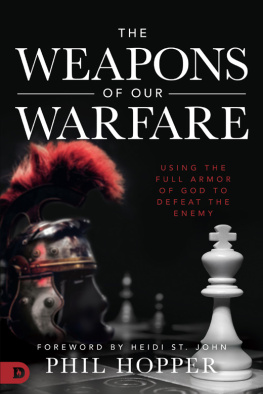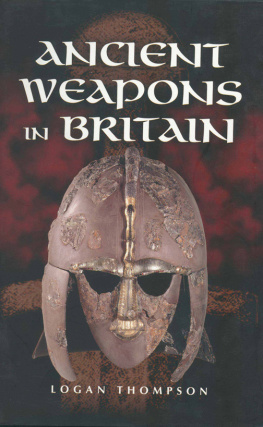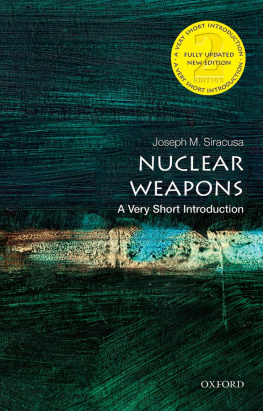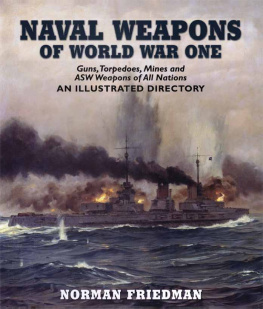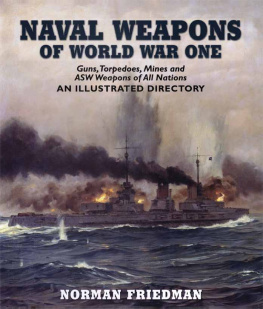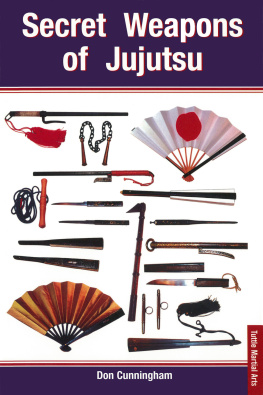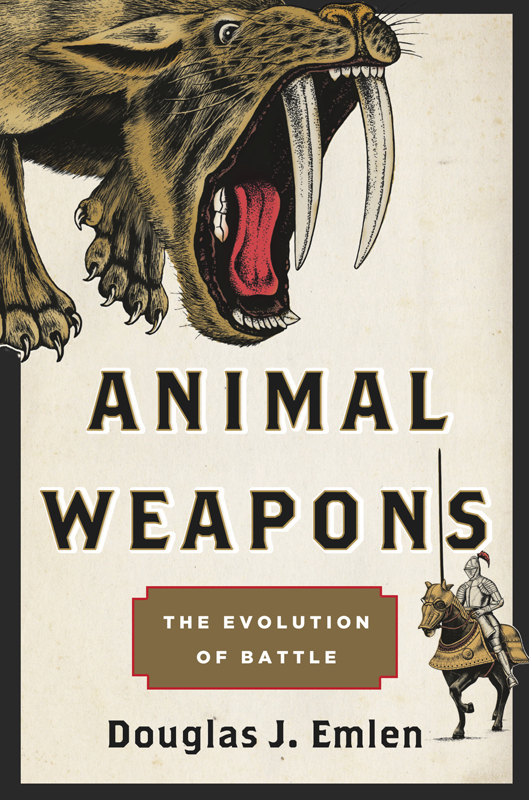Contents
Guide
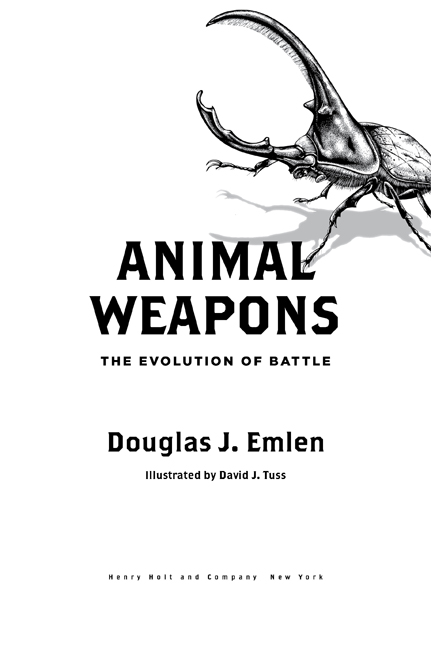
The author and publisher have provided this e-book to you for your personal use only. You may not make this e-book publicly available in any way. Copyright infringement is against the law. If you believe the copy of this e-book you are reading infringes on the authors copyright, please notify the publisher at: us.macmillanusa.com/piracy.
Contents
I know not with what weapons World War III will be fought, but World War IV will be fought with sticks and stones.
A LBERT E INSTEIN
Preface
For as long as I can remember Ive been obsessed with big weapons, which is rather surprising given that I descend from a long line of Quakers. On field trips to the natural history museum it wasnt birds or zebras that caught my eye; it was mastodons with curling tusks, or triceratops with five-foot-long horns. In every room, it seemed, loomed another species with a crazy protrusion jutting from its head, or from between the shoulder blades, or from the end of its tail. Gallic moose wielded twelve-foot-wide antlers, and arsinotheres had horns six feet long and a foot wide at the base. I couldnt peel my eyes from these creatures. Why were their weapons so big?
As I grew and, in particular, as I learned more about biology, I realized that big had little to do with absolute size. Extreme weapons were all about proportion. Some of the most magnificent structures are borne by tiny creatures. Hiding in drawer after drawer of dried, pinned specimens in museum archives, for example, are uncountable numbers of oddball species: beetles with front legs so long they have to be folded awkwardly around the animal in order to shut the lid on the case, or horns so big the animals have to be mounted in the drawer sideways. Many species are so small that their weapons become apparent only with a microscope: twisted tusks protruding from the faces of West African wasps, for example, or broad, branched antlers adorning the faces of flies.
I began my career determined to study extreme weapons, so I set out to find the craziest, most bizarre animals that I could. I also wanted my research to take me someplace exotic. In my case, this meant the tropics, so I narrowed my search. My study animals needed to be easy to find in large numbers, to observe in the wild, and to rear in captivity. As fate would have it, the animals that best fit this bill were dung beetles. I resisted at first. After all, dung beetles lack the panache of elk or moose and, well, they eat dung. Dung beetles were also a tough sell whenever I tried to explain what I did to anyone outside of biology. My father-in-law springs to mindhes a retired U.S. Air Force coloneland Ill never forget breaking it to him that I wanted to take his daughter with me to a remote field station in the thick of a tropical rainforest so I could watch dung beetles.
But dung beetles really were the best animals for testing the ideas I wanted to test, and there were lots of them in the tropics. Squat like little tortoises, these beetles were armed to the teeth with spectacular horns. Better yet, almost nothing was known about how these weapons were used, why they were so big, or why species differed so incredibly in the numbers and shapes of horns that they produced. To a biologist, that kind of unknown is intoxicating. Like exploring the depths of the ocean or outer space, I was going to plunge into the abyss of the biological void, and I was going to learn about extreme weapons in the process.
Two decades later, I remain just as awestruck by beetle weapons as I was that first year in the tropics. Ive followed their stories to Africa, Australia, and throughout Central and South America. Ive also had a chance now to step back from beetles, to consolidate the lessons learned by biologists studying a plethora of extreme weapons in animals ranging from moose flies and fiddler crabs to elephants and elk. These are the stories I set out to tell in these pages, weaving together for the first time the narratives of natures most extravagant creatures.
In the process of weaving their histories together, it became clear that there was another species that belonged in the mix: humans. The more I sought common threadsthemes uniting the stories of diverse animal speciesthe more apparent it became that these threads applied to our own weapons, too. In the end, my book about animal weapons evolved into a book about extreme weapons everywhere. I pored deeper into the literature surrounding our past, searching for the environments and circumstances in which our most elaborate weapons evolved. To my amazement, these circumstances truly were the same, and I realized I couldnt tell one story without telling the other. Back and forth I went, as the biology of animal weapons and our weapons fused, inextricably woven into a single tale. This is a book about extreme weapons. Lets just leave it at that.
Extremes
It was a cold, clear mountain night. The Milky Way streaked across the sky; jagged peaks loomed black against the starlight. A college buddy of mine and I were camping in Rocky Mountain National Park. It was early fallpeak of the rut for elk. Id insisted we take the most remote campsite possible, and wed pitched our tent as far away from the rest as we thought we could get away with. I wanted to be surrounded by aspen and cottonwood, not other people.
Somewhere around two a.m. I jolted awake, sleep still spinning in my head. A gunshot? I sat there in the silence listening. It came again crack ! In an instant I knew what was happening, and it was no gunshot. I shook Scott awake and we bolted from the tent. Almost a ton of testosterone-driven rage exploded beside us in the blackness not twenty feet away. Mature bull elk easily weigh in at eight hundred pounds apiece, and the two bulls locked in combat before us wouldnt even notice if they trampled a tent or its occupants in the scuffle.
There we stood, shivering, bare feet burning in the new frost, squinting in awe at the shadowy beasts clashing beside us. The bulls circled, assessing each other, and then lowered their heads and slammed. Antlers clacked as they locked heads, gigantic silhouettes straining, grunting, gouging divots from the earth each time they lunged. Hindquarters whirled by our tent as they quickstepped their ancient dance, oblivious to the world around them. In the end, we didnt get trampled, and our tent survived unscathed. But images from that September night fifteen years ago stay etched in my mind. I still remember steam rising from their breath in swirling clouds against the dark shadows. I even remember the smell, thick and musky, from the oil glands on the bulls faces.
By any account, elk are magnificent beasts, icons of power and beauty. But most of what impresses us sticks out from the tops of their heads. Its the antlers that inspire our wonder. The weapons. The racks of elk, red deer, moose, and caribou have added regal splendor to the walls of royal halls for centuries. Indeed, no self-respecting chateau or castle would be complete without them. Antler-wielding stags are one of the most pervasive symbols in heraldic coats of arms, and mounted heads with antlers or horns grace the fireplaces of innumerable hunters dens, sporting goods stores, restaurants, and bars, reflecting silent glory upon the ones who slayed them.
Obsession with animal weapons is nothing new. The earliest known paintings attributable to our species, inked onto the smoky walls of caves more than thirty thousand years ago, feature the branching antlers of stags, curved mastodon tusks, and rhinoceros and buffalo horns. Today, antlers and horns are embedded into the brand strategies of corporations ranging from single malt scotch (Glenfiddich, The Dalmore) and other spirits (Jgermeister, Moosehead Lager), to farm equipment (John Deere), firearms (Browning), automobiles (Porsche, Dodge), clothing (Abercrombie & Fitch), mountaineering gear (Mammut), sports franchises (Manitoba Moose, St. Louis Rams, Milwaukee Bucks, Texas Longhorns), and even pharmaceutical companies (Janssen) and investment firms (The Hartford, Merrill Lynch). No matter how you stack it, we love antlers and horns.



